Abstract
The microenzyme-linked immunosorbent assay (ELISA) for the detection of immunoglobulin M and G (IgM, IgG) antibodies to Legionella pneumophila serogroup 1 antigens was evaluated. IgM antibodies were measured by both double-sandwich and single-sandwich techniques. These assays were compared with the previously standardized indirect immunofluorescence test in four groups of subjects: (i) pneumonia patients with culture-proven Legionnaires disease with serogroup 1 isolates, (ii) pneumonia patients with serogroup 1 organisms detected by direct immunofluorescence testing of respiratory secretions but without culture confirmation, (iii) pneumonia patients with negative culture and direct immunofluorescence tests, and (iv) healthy hospital employees. In addition, the sensitivity and specificity of the IgG ELISA were evaluated with larger groups of controls and Legionnaires disease patients. The ELISA was more sensitive than the indirect immunofluorescence test. However, it detected antibody rises in pneumonia patients without culture or direct immunofluorescence evidence of L. pneumophila serogroup 1 infection, thereby suggesting that the specificity of the ELISA was slightly lower than that of the indirect immunofluorescence test. The double-sandwich ELISA was a sensitive method for detecting IgM antibodies and, as previously reported, appeared to be free from interference by rheumatoid factor. IgM anti-Legionella antibodies detected by the ELISA appeared earlier and were less persistent than IgG antibodies. In addition, the IgM ELISA was useful in detecting antibodies in necropsy serum samples obtained from patients dying acutely of Legionnaires disease. The data presented show that the ELISA is a reliable method for the detection of specific anti-Legionella antibodies.
Full text
PDF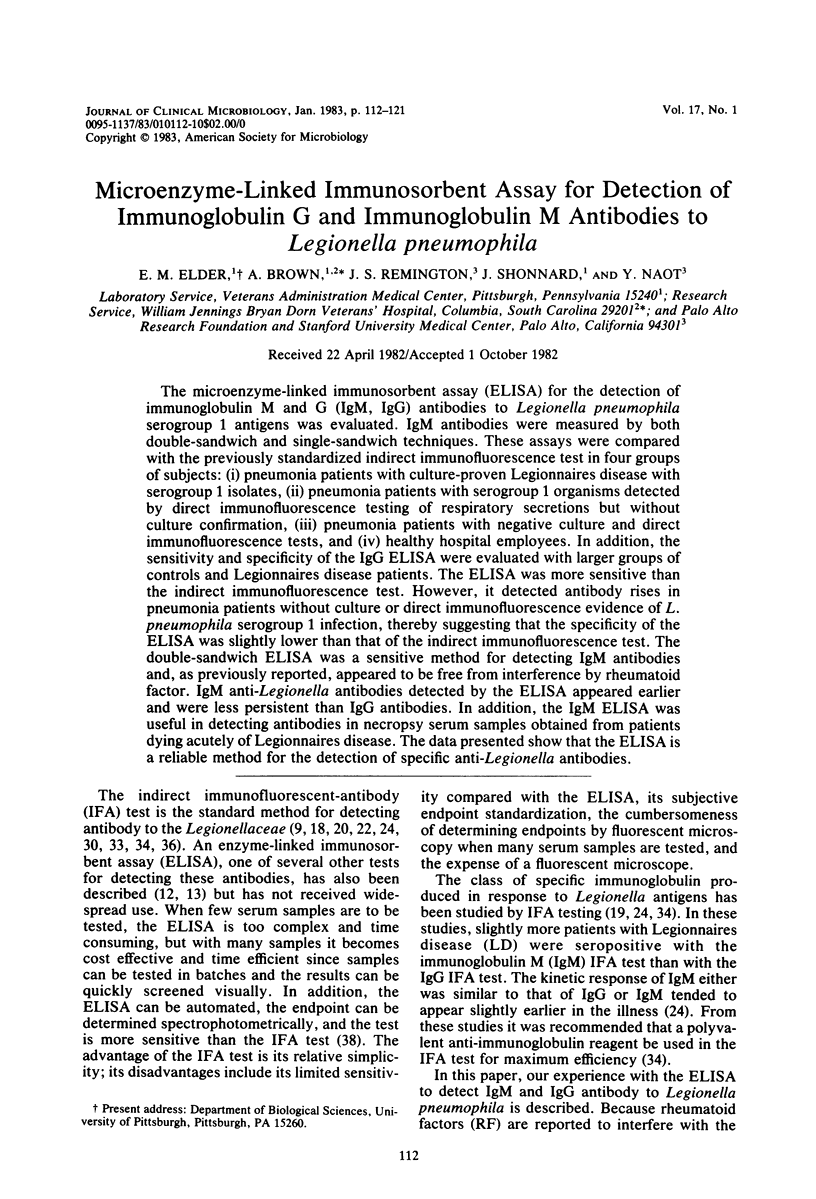
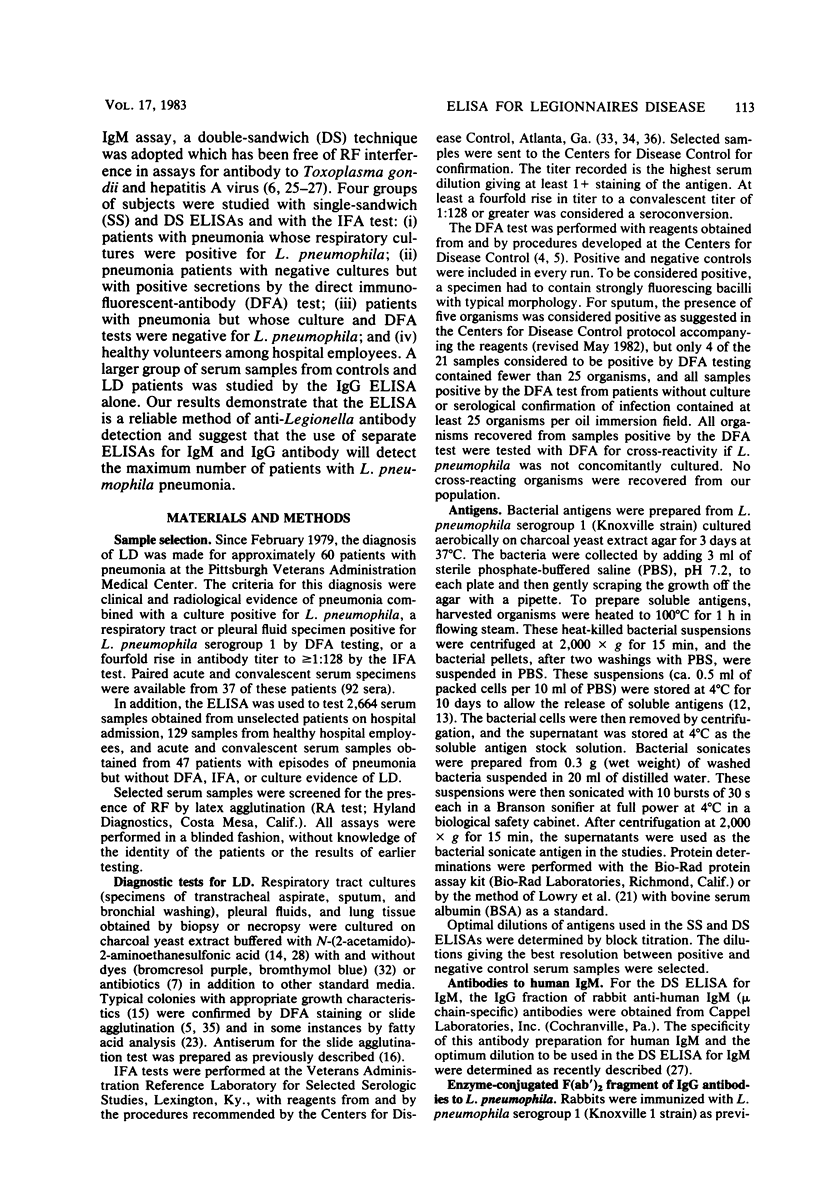
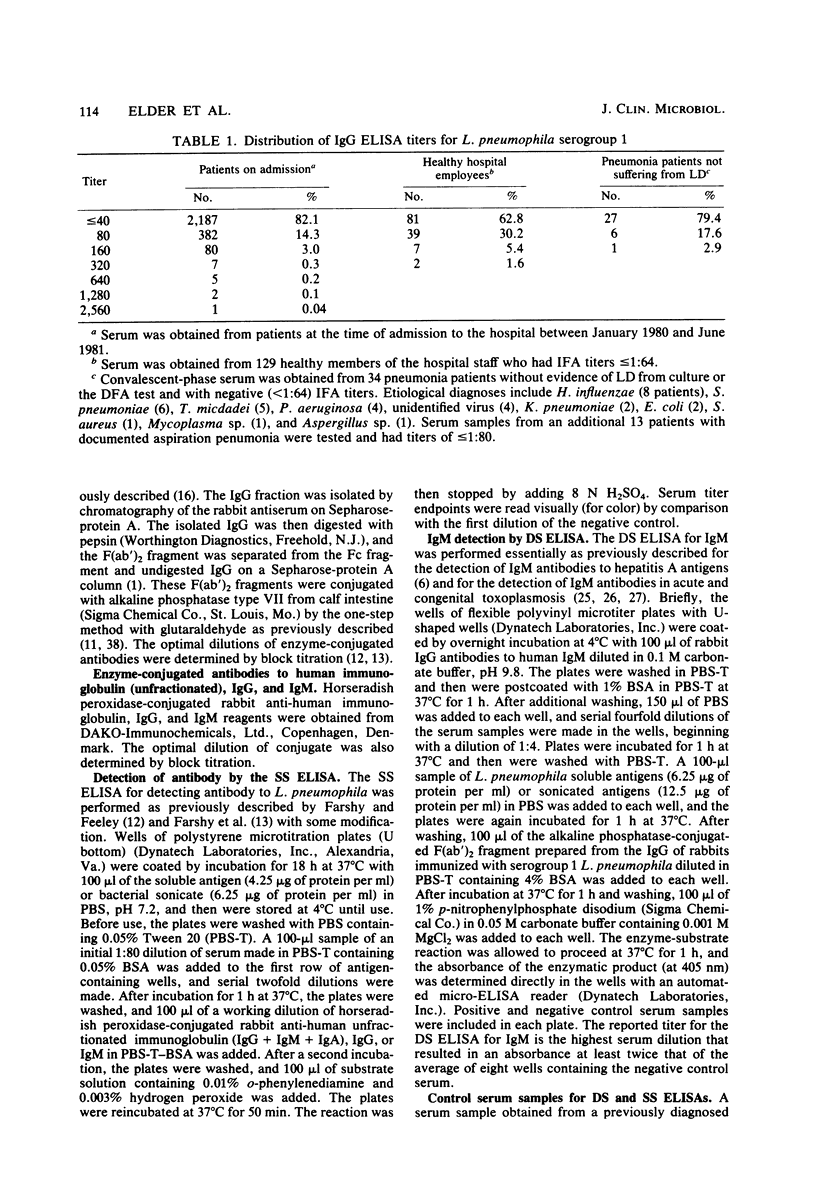
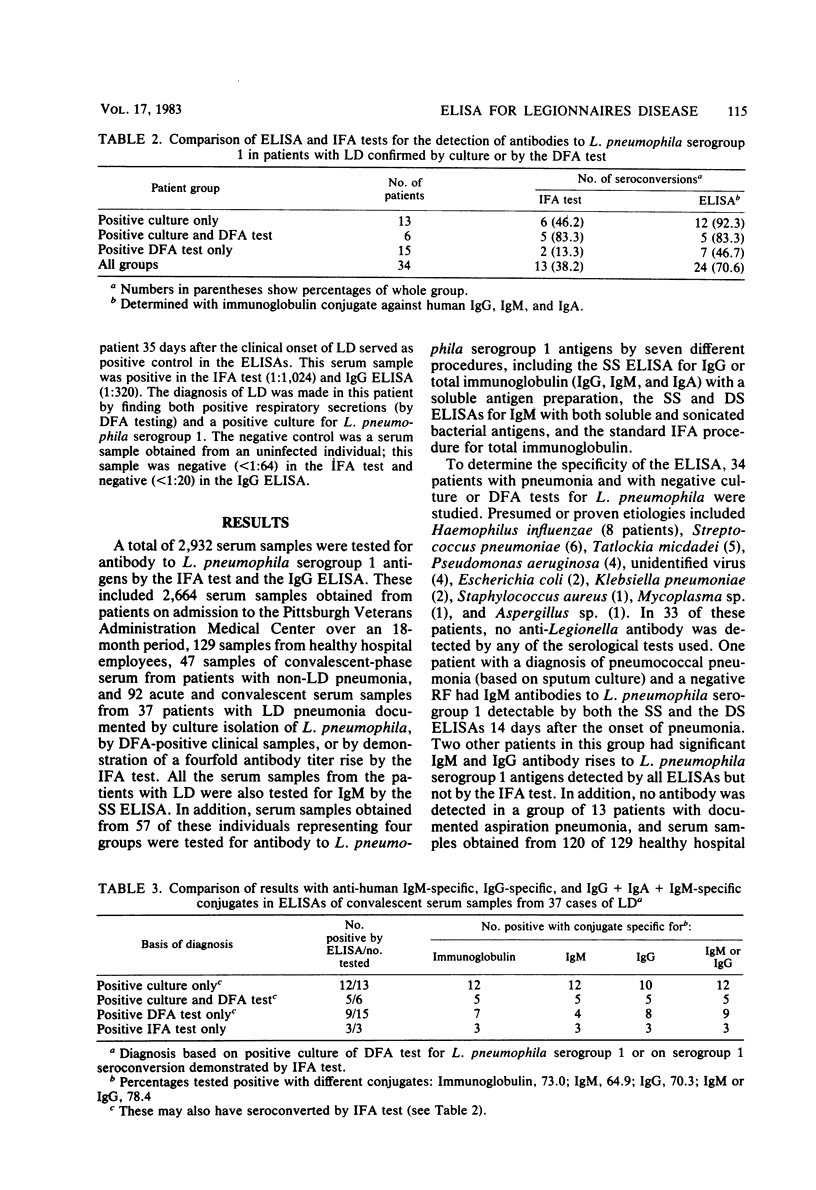
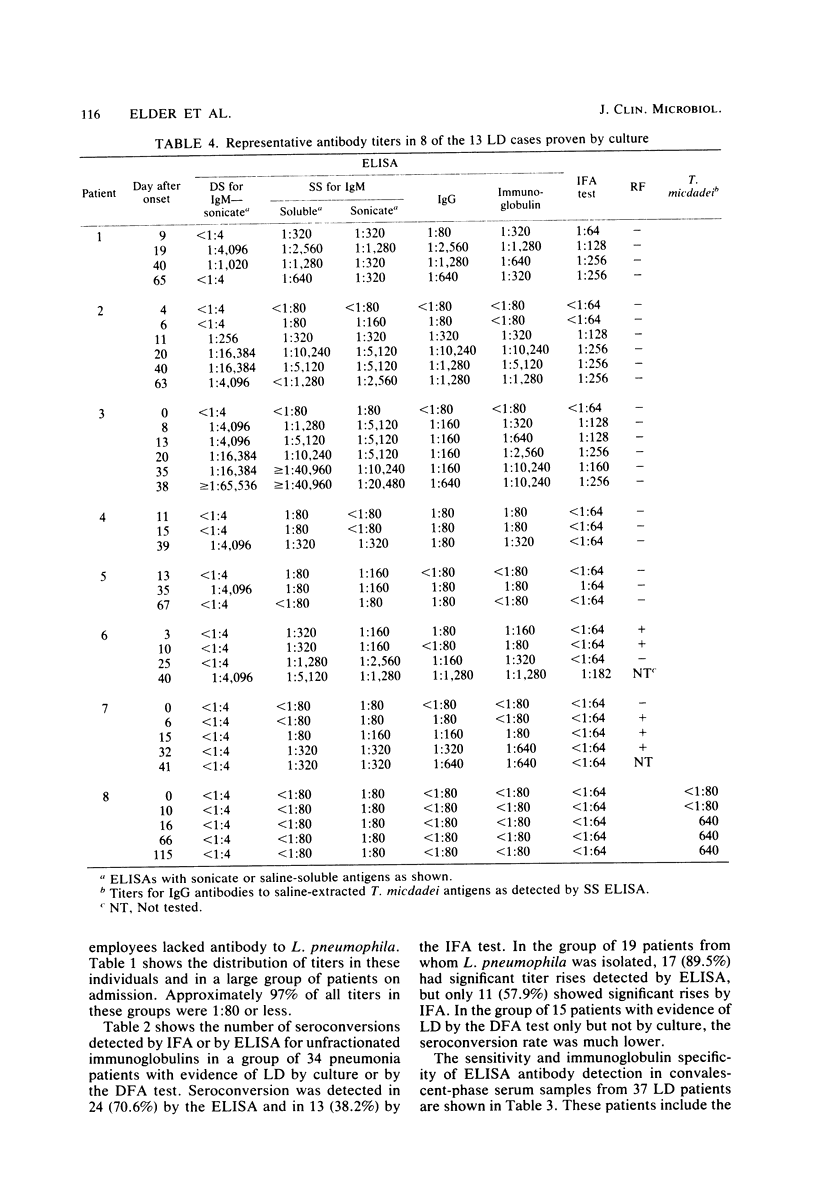
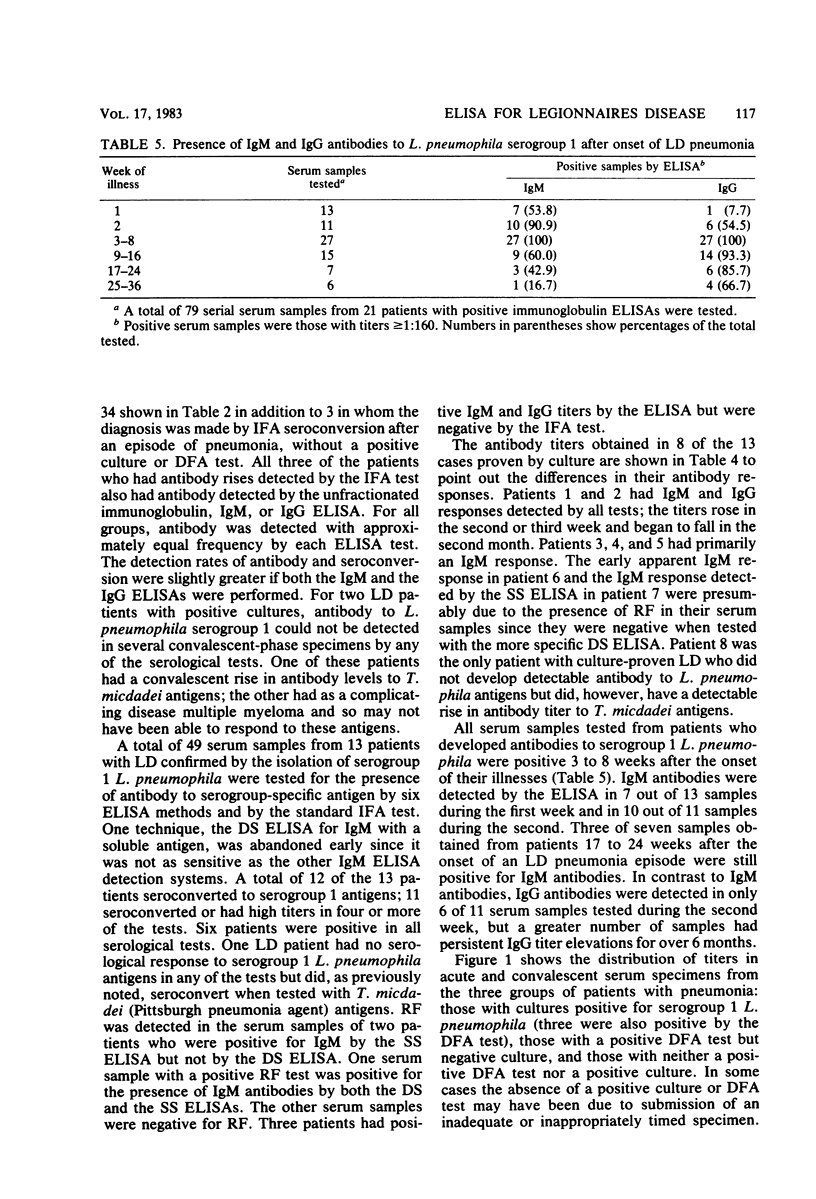
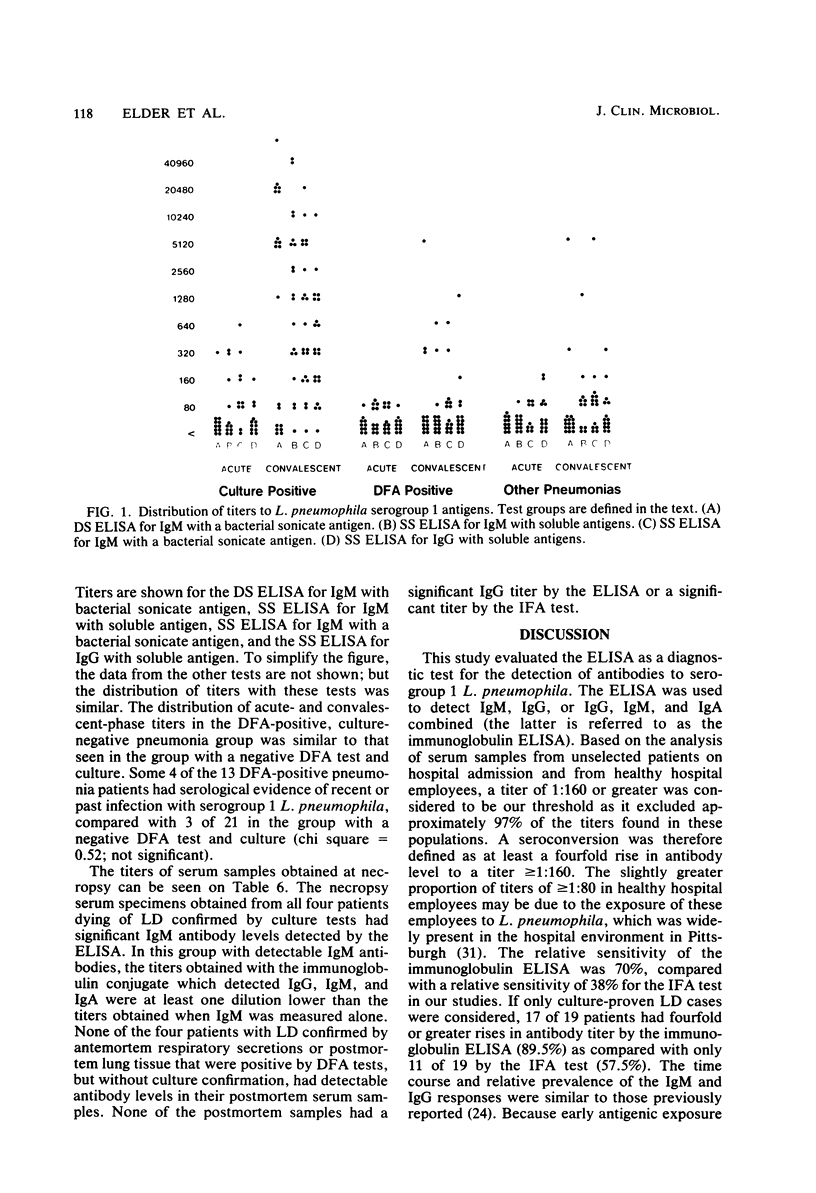
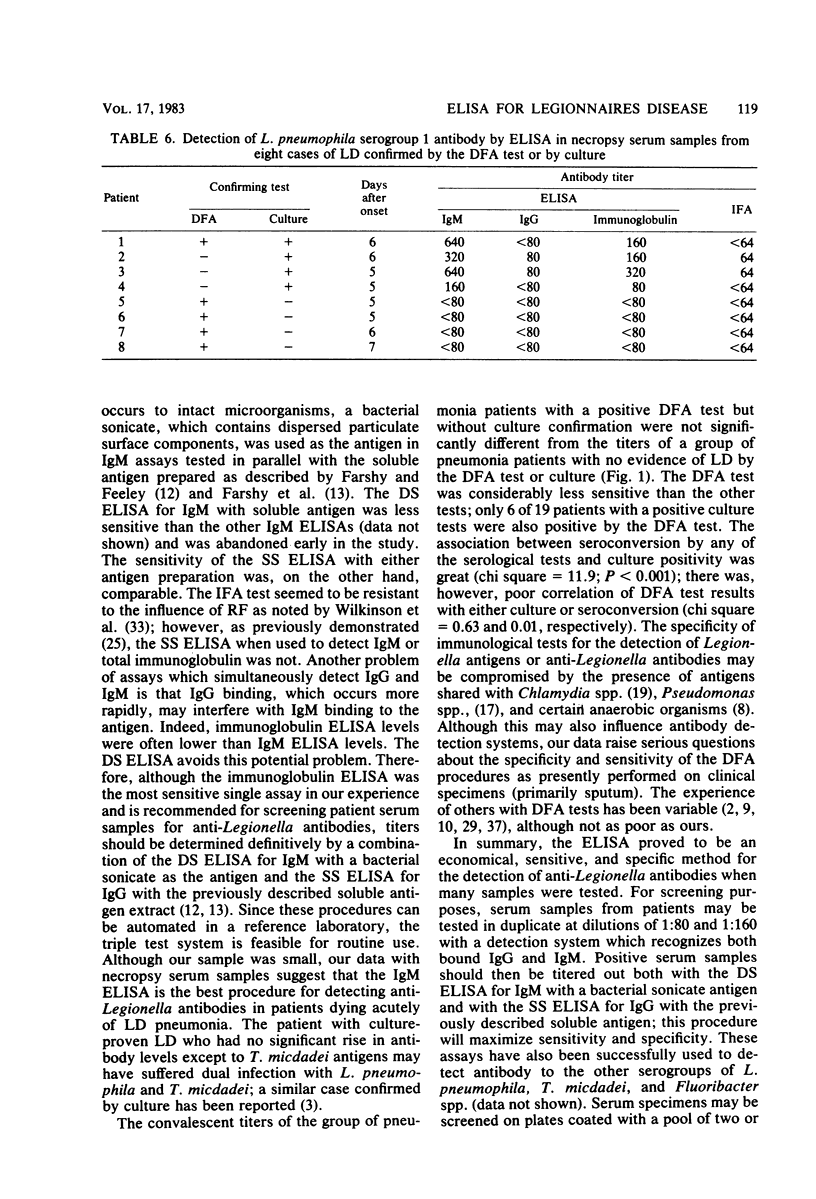

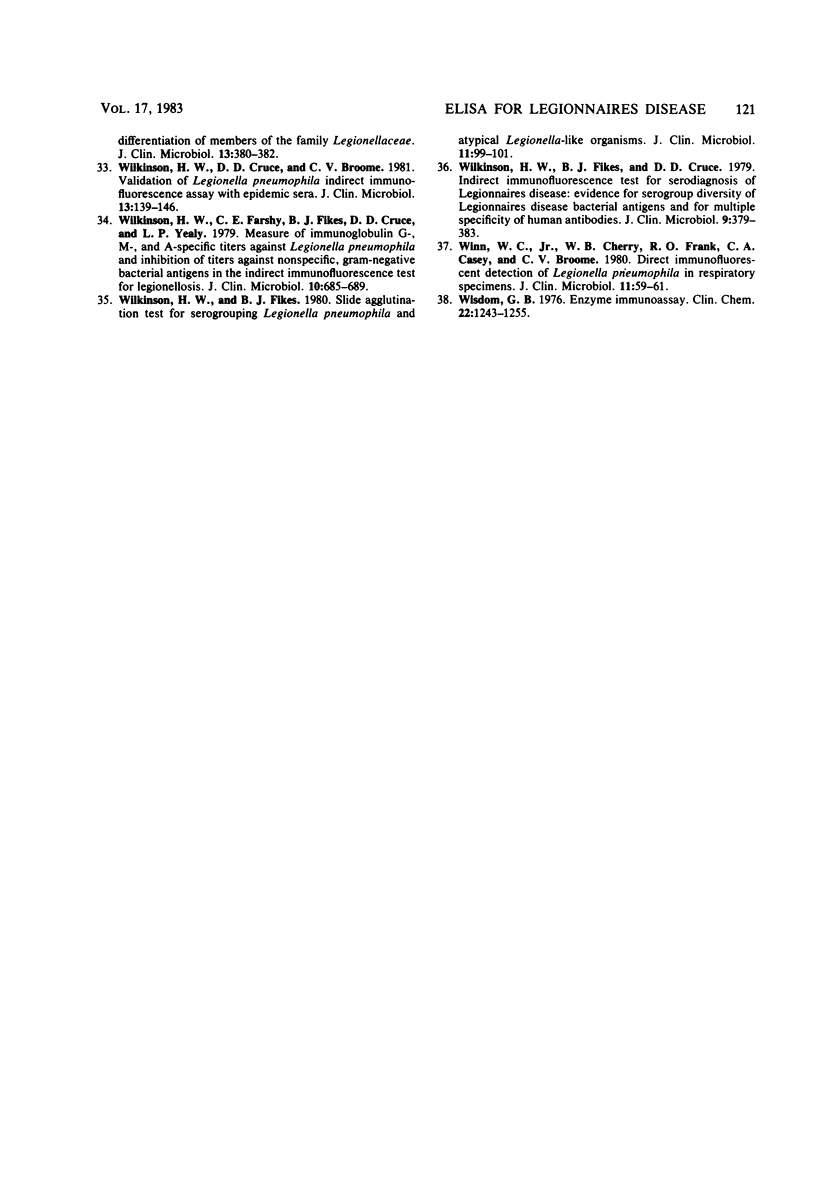
Selected References
These references are in PubMed. This may not be the complete list of references from this article.
- Araujo F. G., Remington J. S. Antigenemia in recently acquired acute toxoplasmosis. J Infect Dis. 1980 Feb;141(2):144–150. doi: 10.1093/infdis/141.2.144. [DOI] [PubMed] [Google Scholar]
- Broome C. V., Cherry W. B., Winn W. C., Jr, MacPherson B. R. Rapid diagnosis of Legionnaires' disease by direct immunofluorescent staining. Ann Intern Med. 1979 Jan;90(1):1–4. doi: 10.7326/0003-4819-90-1-1. [DOI] [PubMed] [Google Scholar]
- Brown A., Shonnard J. W., Geyer S. J., Rihs J., Elder E., Stout J., Vickers R., Yu V. Coincident infection with legionnaires' disease bacterium and Pittsburgh pneumonia agent. Lancet. 1981 Nov 7;2(8254):1041–1041. doi: 10.1016/s0140-6736(81)91231-9. [DOI] [PubMed] [Google Scholar]
- Cherry W. B., Pittman B., Harris P. P., Hebert G. A., Thomason B. M., Thacker L., Weaver R. E. Detection of Legionnaires disease bacteria by direct immunofluorescent staining. J Clin Microbiol. 1978 Sep;8(3):329–338. doi: 10.1128/jcm.8.3.329-338.1978. [DOI] [PMC free article] [PubMed] [Google Scholar]
- Duermeyer W., van der Veen J. Specific detection of IgM-antibodies by ELISA, applied in hepatitis-A. Lancet. 1978 Sep 23;2(8091):684–685. doi: 10.1016/s0140-6736(78)92802-7. [DOI] [PubMed] [Google Scholar]
- Edelstein P. H., Finegold S. M. Use of a semiselective medium to culture Legionella pneumophila from contaminated lung specimens. J Clin Microbiol. 1979 Aug;10(2):141–143. doi: 10.1128/jcm.10.2.141-143.1979. [DOI] [PMC free article] [PubMed] [Google Scholar]
- Edelstein P. H., McKinney R. M., Meyer R. D., Edelstein M. A., Krause C. J., Finegold S. M. Immunologic diagnosis of Legionnaires' disease: cross-reactions with anaerobic and microaerophilic organisms and infections caused by them. J Infect Dis. 1980 May;141(5):652–655. doi: 10.1093/infdis/141.5.652. [DOI] [PubMed] [Google Scholar]
- Edelstein P. H., Meyer R. D., Finegold S. M. Laboratory diagnosis of Legionnaires' disease. Am Rev Respir Dis. 1980 Feb;121(2):317–327. doi: 10.1164/arrd.1980.121.2.317. [DOI] [PubMed] [Google Scholar]
- England A. C., 3rd, Fraser D. W., Plikaytis B. D., Tsai T. F., Storch G., Broome C. V. Sporadic legionellosis in the United States: the first thousand cases. Ann Intern Med. 1981 Feb;94(2):164–170. doi: 10.7326/0003-4819-94-2-164. [DOI] [PubMed] [Google Scholar]
- Engvall E., Perlmann P. Enzyme-linked immunosorbent assay, Elisa. 3. Quantitation of specific antibodies by enzyme-labeled anti-immunoglobulin in antigen-coated tubes. J Immunol. 1972 Jul;109(1):129–135. [PubMed] [Google Scholar]
- Farshy C. E., Klein G. C., Feeley J. C. Detection of antibodies to legionnaires disease organism by microagglutination and micro-enzyme-linked immunosorbent assay tests. J Clin Microbiol. 1978 Apr;7(4):327–331. doi: 10.1128/jcm.7.4.327-331.1978. [DOI] [PMC free article] [PubMed] [Google Scholar]
- Feeley J. C., Gibson R. J., Gorman G. W., Langford N. C., Rasheed J. K., Mackel D. C., Baine W. B. Charcoal-yeast extract agar: primary isolation medium for Legionella pneumophila. J Clin Microbiol. 1979 Oct;10(4):437–441. doi: 10.1128/jcm.10.4.437-441.1979. [DOI] [PMC free article] [PubMed] [Google Scholar]
- Garrity G. M., Elder E. M., Davis B., Vickers R. M., Brown A. Serological and genotypic diversity among serogroup 5- reacting environmental Legionella isolates. J Clin Microbiol. 1982 Apr;15(4):646–653. doi: 10.1128/jcm.15.4.646-653.1982. [DOI] [PMC free article] [PubMed] [Google Scholar]
- Klein G. C. Cross-reaction to Legionella pneumophila antigen in sera with elevated titers to Pseudomonas pseudomallei. J Clin Microbiol. 1980 Jan;11(1):27–29. doi: 10.1128/jcm.11.1.27-29.1980. [DOI] [PMC free article] [PubMed] [Google Scholar]
- LOWRY O. H., ROSEBROUGH N. J., FARR A. L., RANDALL R. J. Protein measurement with the Folin phenol reagent. J Biol Chem. 1951 Nov;193(1):265–275. [PubMed] [Google Scholar]
- Lattimer G. L., Cepil B. A. Legionnaires' disease serology. Effect of antigen preparation on specificity and sensitivity of the indirect fluorescent antibody test. J Clin Pathol. 1980 Jun;33(6):585–590. doi: 10.1136/jcp.33.6.585. [DOI] [PMC free article] [PubMed] [Google Scholar]
- Lattimer G. L., Ormsbee R. A., Peacock M. G., Rhodes L. V. Diagnostic specificity of immunoglobulin M (IgM) response in differentiation Legionnaires' disease from psittacosis. Scand J Infect Dis. 1979;11(4):271–273. doi: 10.3109/inf.1979.11.issue-4.03. [DOI] [PubMed] [Google Scholar]
- Lennette D. A., Lennette E. T., Wentworth B. B., French M. L., Lattimer G. L. Serology of Legionnaires disease: comparison of indirect fluorescent antibody, immune adherence hemagglutination, and indirect hemagglutination tests. J Clin Microbiol. 1979 Dec;10(6):876–879. doi: 10.1128/jcm.10.6.876-879.1979. [DOI] [PMC free article] [PubMed] [Google Scholar]
- McKinney R. M., Wilkinson H. W., Sommers H. M., Fikes B. J., Sasseville K. R., Yungbluth M. M., Wolf J. S. Legionella pneumophila serogroup six: isolation from cases of legionellosis, identification by immunofluorescence staining, and immunological response to infection. J Clin Microbiol. 1980 Sep;12(3):395–401. doi: 10.1128/jcm.12.3.395-401.1980. [DOI] [PMC free article] [PubMed] [Google Scholar]
- Moss C. W., Weaver R. E., Dees S. B., Cherry W. B. Cellular fatty acid composition of isolates from Legionnaires disease. J Clin Microbiol. 1977 Aug;6(2):140–143. doi: 10.1128/jcm.6.2.140-143.1977. [DOI] [PMC free article] [PubMed] [Google Scholar]
- Nagington J., Wreghitt T. G., Tobin J. O., Macrae A. D. The antibody response in Legionnaires' disease. J Hyg (Lond) 1979 Oct;83(2):377–381. doi: 10.1017/s0022172400026176. [DOI] [PMC free article] [PubMed] [Google Scholar]
- Naot Y., Barnett E. V., Remington J. S. Method for avoiding false-positive results occurring in immunoglobulin M enzyme-linked immunosorbent assays due to presence of both rheumatoid factor and antinuclear antibodies. J Clin Microbiol. 1981 Jul;14(1):73–78. doi: 10.1128/jcm.14.1.73-78.1981. [DOI] [PMC free article] [PubMed] [Google Scholar]
- Naot Y., Desmonts G., Remington J. S. IgM enzyme-linked immunosorbent assay test for the diagnosis of congenital Toxoplasma infection. J Pediatr. 1981 Jan;98(1):32–36. doi: 10.1016/s0022-3476(81)80528-8. [DOI] [PubMed] [Google Scholar]
- Naot Y., Remington J. S. An enzyme-linked immunosorbent assay for detection of IgM antibodies to Toxoplasma gondii: use for diagnosis of acute acquired toxoplasmosis. J Infect Dis. 1980 Nov;142(5):757–766. doi: 10.1093/infdis/142.5.757. [DOI] [PubMed] [Google Scholar]
- Pasculle A. W., Feeley J. C., Gibson R. J., Cordes L. G., Myerowitz R. L., Patton C. M., Gorman G. W., Carmack C. L., Ezzell J. W., Dowling J. N. Pittsburgh pneumonia agent: direct isolation from human lung tissue. J Infect Dis. 1980 Jun;141(6):727–732. doi: 10.1093/infdis/141.6.727. [DOI] [PubMed] [Google Scholar]
- Saravolatz L. D., Russell G., Cvitkovich D. Direct immunofluorescence in the diagnosis of Legionnaires' disease. Chest. 1981 May;79(5):566–570. doi: 10.1378/chest.79.5.566. [DOI] [PubMed] [Google Scholar]
- Storch G., Hayes P. S., Hill D. L., Baine W. B. Prevalence of antibody to Legionella pneumophila in middle-aged and elderly Americans. J Infect Dis. 1979 Nov;140(5):784–788. doi: 10.1093/infdis/140.5.784. [DOI] [PubMed] [Google Scholar]
- Stout J., Yu V. L., Vickers R. M., Zuravleff J., Best M., Brown A., Yee R. B., Wadowsky R. Ubiquitousness of Legionella pneumophila in the water supply of a hospital with endemic Legionnaires' disease. N Engl J Med. 1982 Feb 25;306(8):466–468. doi: 10.1056/NEJM198202253060807. [DOI] [PubMed] [Google Scholar]
- Vickers R. M., Brown A., Garrity G. M. Dye-containing buffered charcoal-yeast extract medium for differentiation of members of the family Legionellaceae. J Clin Microbiol. 1981 Feb;13(2):380–382. doi: 10.1128/jcm.13.2.380-382.1981. [DOI] [PMC free article] [PubMed] [Google Scholar]
- Wilkinson H. W., Cruce D. D., Broome C. V. Validation of Legionella pneumophila indirect immunofluorescence assay with epidemic sera. J Clin Microbiol. 1981 Jan;13(1):139–146. doi: 10.1128/jcm.13.1.139-146.1981. [DOI] [PMC free article] [PubMed] [Google Scholar]
- Wilkinson H. W., Farshy C. E., Fikes B. J., Cruce D. D., Yealy L. P. Measure of immunoglobulin G-, M-, and A-specific titers against Legionella pneumophila and inhibition of titers against nonspecific, gram-negative bacterial antigens in the indirect immunofluorescence test for legionellosis. J Clin Microbiol. 1979 Nov;10(5):685–689. doi: 10.1128/jcm.10.5.685-689.1979. [DOI] [PMC free article] [PubMed] [Google Scholar]
- Wilkinson H. W., Fikes B. J., Cruce D. D. Indirect immunofluorescence test for serodiagnosis of Legionnaires disease: evidence for serogroup diversity of Legionnaires disease bacterial antigens and for multiple specificity of human antibodies. J Clin Microbiol. 1979 Mar;9(3):379–383. doi: 10.1128/jcm.9.3.379-383.1979. [DOI] [PMC free article] [PubMed] [Google Scholar]
- Wilkinson H. W., Fikes B. J. Slide agglutination test for serogrouping Legionella pneumophila and atypical Legionella-like organisms. J Clin Microbiol. 1980 Jan;11(1):99–101. doi: 10.1128/jcm.11.1.99-101.1980. [DOI] [PMC free article] [PubMed] [Google Scholar]
- Winn W. C., Jr, Cherry W. B., Frank R. O., Casey C. A., Broome C. V. Direct immunofluorescent detection of Legionella pneumophila in respiratory specimens. J Clin Microbiol. 1980 Jan;11(1):59–64. doi: 10.1128/jcm.11.1.59-64.1980. [DOI] [PMC free article] [PubMed] [Google Scholar]
- Wisdom G. B. Enzyme-immunoassay. Clin Chem. 1976 Aug;22(8):1243–1255. [PubMed] [Google Scholar]


